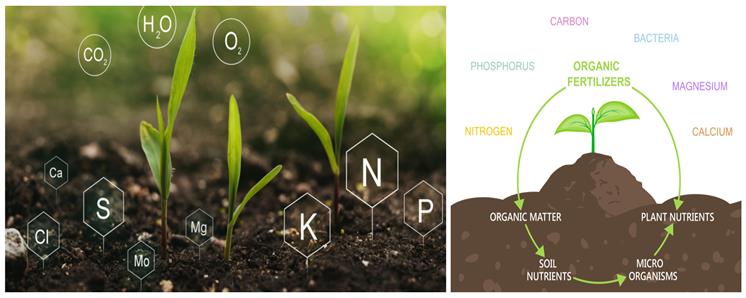PDF chapter test TRY NOW
There are two major types of nutrients that plants seek for their growth, such as macronutrients and micronutrients.
Macronutrients are the nutrients required by plants in large quantities.
Example:
Nitrogen (N), phosphorus (P), potassium (K), calcium (Ca), sulfur (S), magnesium (Mg), carbon (C), oxygen (O), hydrogen (H).
Micronutrients are the nutrients required by plants in small quantities.
Example:
Iron (Fe), boron (B), chlorine (Cl), manganese (Mn), zinc (Zn), copper (Cu), molybdenum (Mo), nickel (Ni).

Macro and micro nutrients present in the soil
Replenishment of nutrient in soil
Plants absorb minerals and nutrients from the soil. So, if we grow plants on soil for a certain period, the soil's amount of nutrients and minerals will decline. So farmers add fertilisers and manures to the soil, which provides nutrients such as nitrogen, potassium, phosphorus etc. These nutrients need to be added from time to keep the soil enriched. In this way, we fulfil the nutritional requirement of the plants and can grow healthy plants.
Plants require a lot of nitrogen. They cannot absorb nitrogen from the air like carbon dioxide. They need nitrogen in soluble form. In leguminous plants, absorption of nitrogen is facilitated by rhizobium bacteria. This bacteria lives in the root nodules of leguminous plants. It converts gaseous nitrogen into a water-soluble form and release it into the soil. Plants absorb this nitrogen in the soil for their growth. In return, Rhizobium bacteria gets their food and shelter from the plant. Thus they have a symbiotic relationship. For farmers, this relationship is of great importance. If they grow grams, peas, moong, beans, and other legumes, nitrogenous fertiliser usage will reduce.
The quality of plants depends upon the quality of the soil. It is necessary to take care of the soil quality to produce a good yield from plants. Therefore, farmers add fertilisers to the ground. These fertilisers enriched the soil with additional nutrients like sodium, potassium, phosphorus, and nitrogen absorbed by the plants and synthesising other food components such as proteins and fats.
Important!
Info bit
Carbohydrates are generated by the process of photosynthesis by the plants. Carbohydrates are made up of carbon, hydrogen and oxygen and are used to synthesis proteins and fats. But proteins require an additional compound, nitrogen. Plants cannot absorb the gaseous nitrogen from the air. Certain bacteria in the soil convert the gaseous nitrogen into an usable form and release it in the soil.
